Why CTOs and CIOs Must Prioritize Custom Tableau Dashboards
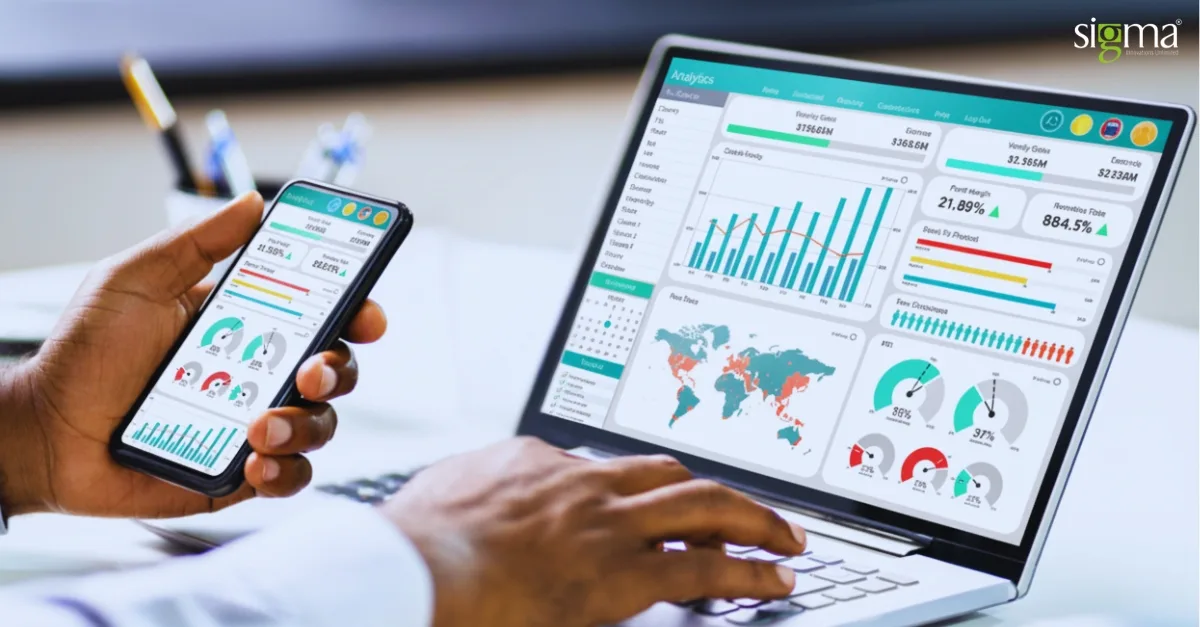
Key Takeaways
- Dashboards as Cockpits – Just like pilots need clear controls, CTOs and CIOs need custom dashboards to steer enterprises safely and strategically.
- From Noise to Symphony – Custom Tableau dashboards turn scattered data points into a harmonized tune, giving leaders clarity instead of chaos.
- Scalability Like a Highway – As data traffic grows, standard dashboards jam up. Custom designs widen thelanes so decision-making keeps moving at full speed.
Data isn’t just the backbone of business—it’s the currency that powers every decision. Yet, even with countless tools and reports at their disposal, many CTOs and CIOs still face the same challenge: turning fragmented data into actionable insights. It’s a classic C-suite dilemma—how do you cut through the noise and make data truly work for the business?
For technology leaders, the responsibility goes far beyond keeping the lights on. Today’s CTOs and CIOs are the architects of digital transformation, expected to drive automation, scalability, and efficiency across the enterprise. The problem? Out-of-the-box dashboards often fall short. They show surface-level metrics but fail to align with the unique KPIs, workflows, and growth goals that modern enterprises demand.
That’s why custom Tableau dashboards have become a strategic imperative. Unlike one-size-fits-all templates, they bring clarity to complexity, integrate seamlessly with enterprise data sources, and empower decision-makers with real-time analytics. Put simply, custom dashboards are no longer a “nice-to-have”—they’re the control center of digital strategy.
At Sigma Infosolutions, we specialize in Tableau development services that go beyond standard dashboard design. Our BI and analytics experts help enterprises and ISVs build tailored data analytics dashboards that deliver meaningful insights, automate reporting, and support faster, smarter business decisions.
With the right Tableau dashboard design, CTOs and CIOs can transform data from scattered signals into a strategic advantage—and that’s exactly where Sigma comes in.
The Evolving Role of CTOs & CIOs in the Data-First Enterprise
The roles of CTOs and CIOs have evolved far beyond their traditional boundaries. In a data-first enterprise, they’re no longer just technology stewards—they’re strategic partners responsible for shaping the organization’s future. When they work in sync, CIOs and CTOs become the dual engines of transformation: one ensuring governance and alignment, the other driving innovation and scalability.
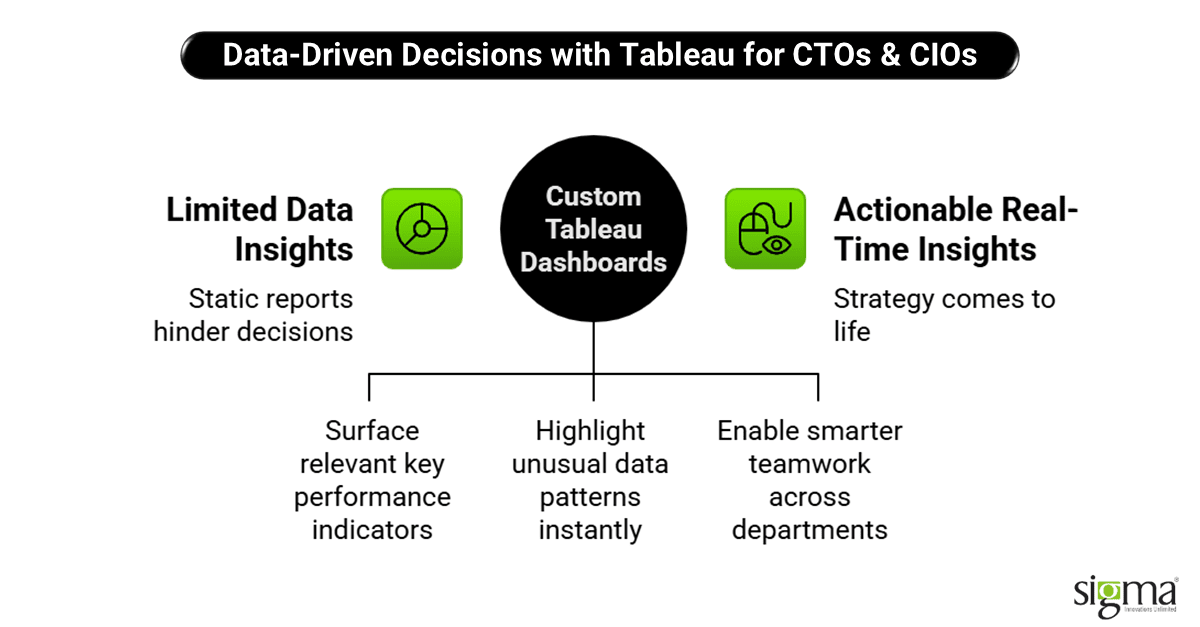
For CIOs, the focus is clear—maintaining compliance, safeguarding data, and ensuring that IT strategy aligns with broader business objectives. They’re the guardians of governance, making sure the business runs smoothly and securely. On the other hand, CTOs wear the innovator’s hat. They’re tasked with building scalable architectures, exploring emerging technologies, and ensuring the enterprise can adapt quickly to market shifts.
But here’s the catch: both leaders need more than just static reports. They need real-time, actionable insights that can guide decisions in fast-moving markets. The global Tableau services market is forecast to grow from $1.3 billion (2024) to $5.8 billion by 2037 (12.8%+ CAGR), reflecting continued investment in custom dashboards and enablement.
This is where custom Tableau dashboards come into play. Instead of drowning in spreadsheets or settling for generic templates, CTOs and CIOs can rely on tailored data analytics dashboards that surface the right KPIs, highlight anomalies instantly, and enable smarter collaboration across departments.
By investing in a Tableau dashboard design that reflects the unique needs of their enterprise, technology leaders can turn raw data into a competitive advantage. In the data-first era, dashboards aren’t just reporting tools—they’re the lens through which strategy comes to life.
Also Read: Turning Data Chaos into Business Confidence with Data Quality Management
The Limitations of Standard Tableau Dashboards
Most enterprises begin their Tableau journey with pre-built templates. At first glance, these standard dashboards seem convenient—fast to deploy and easy to use. But for CTOs and CIOs navigating today’s complex data ecosystems, the cracks quickly begin to show. Generic dashboards may work for basic reporting, but they rarely deliver the depth, flexibility, or scalability that modern enterprises require.
Here are some of the most common pain points technology leaders encounter with standard Tableau dashboards:
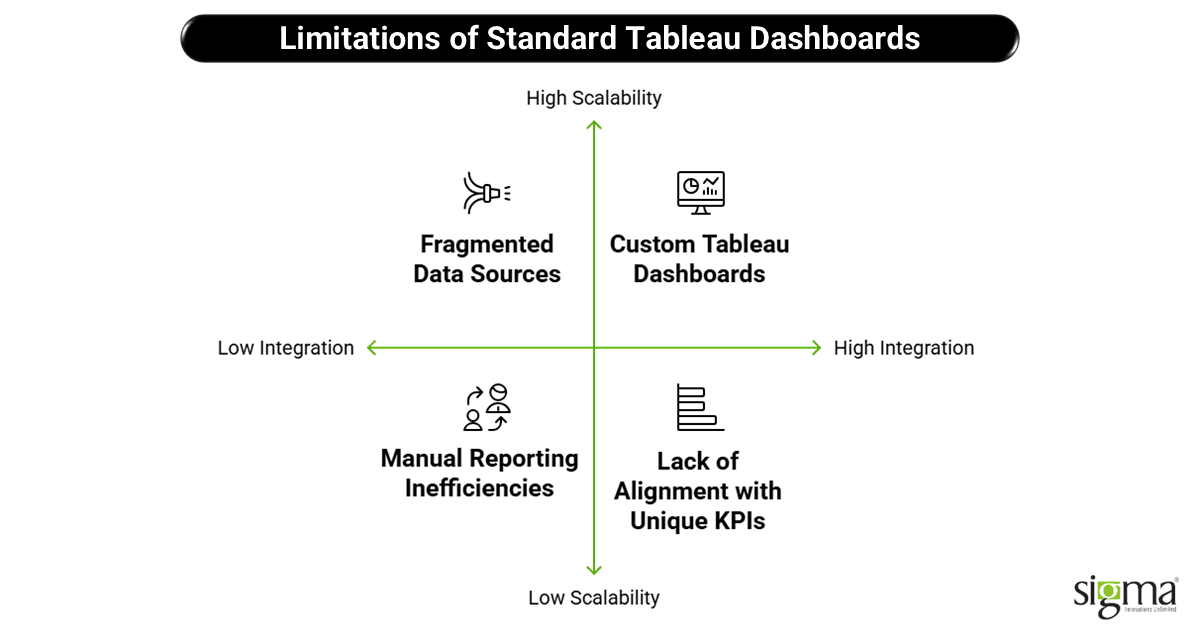
- Fragmented Data Sources: Most enterprises rely on a mix of ERP systems, CRMs, cloud applications, and even legacy platforms. Standard dashboards struggle to integrate these sources seamlessly, leaving leaders with siloed insights instead of a unified picture.
- Manual Reporting Inefficiencies: Without customization, teams often resort to exporting data, merging spreadsheets, or applying manual adjustments just to get accurate reports. This slows down decision-making and increases the risk of human error.
- Lack of Alignment with Unique KPIs: Every enterprise runs on its own set of success metrics. Out-of-the-box dashboards may show standard performance indicators but often miss the nuanced KPIs that matter most to the business. For CTOs and CIOs, this means they’re making critical decisions without the right context.
- Inability to Scale with Data Growth: As organizations expand, so does the volume, variety, and velocity of data. Standard Tableau dashboards aren’t designed to handle complex scaling needs, making it harder to analyze real-time data at enterprise speed.
When these limitations pile up, the impact is significant. Instead of empowering leaders, standard dashboards can actually slow down strategic decision-making. CTOs may find themselves chasing innovation without clear visibility into system performance, while CIOs may struggle to maintain governance and compliance with incomplete data.
In short, what starts as a quick fix often becomes a long-term barrier. That’s why more technology leaders are turning to custom Tableau dashboards—not as a luxury, but as a necessity to align data visualization with enterprise strategy.
With a thoughtful Tableau dashboard design, CTOs and CIOs can move past the limits of generic templates and build a foundation for smarter, faster, and more scalable decision-making.
Why Custom Tableau Dashboards Are a Strategic Imperative
Think of standard dashboards as “off-the-shelf suits.” They might fit okay at first, but they’re rarely tailored to your exact needs. For CTOs and CIOs leading data-first enterprises, that just doesn’t cut it anymore. What they need are dashboards that fit like a custom-tailored suit—built to align with their business goals, growth stage, and evolving technology stack. That’s exactly where custom Tableau dashboards come into play.
Unlike pre-built templates, custom dashboards are designed with enterprise complexity in mind. They unify data, surface insights that matter, and scale effortlessly as the business grows. Here’s why they’ve become a strategic imperative:
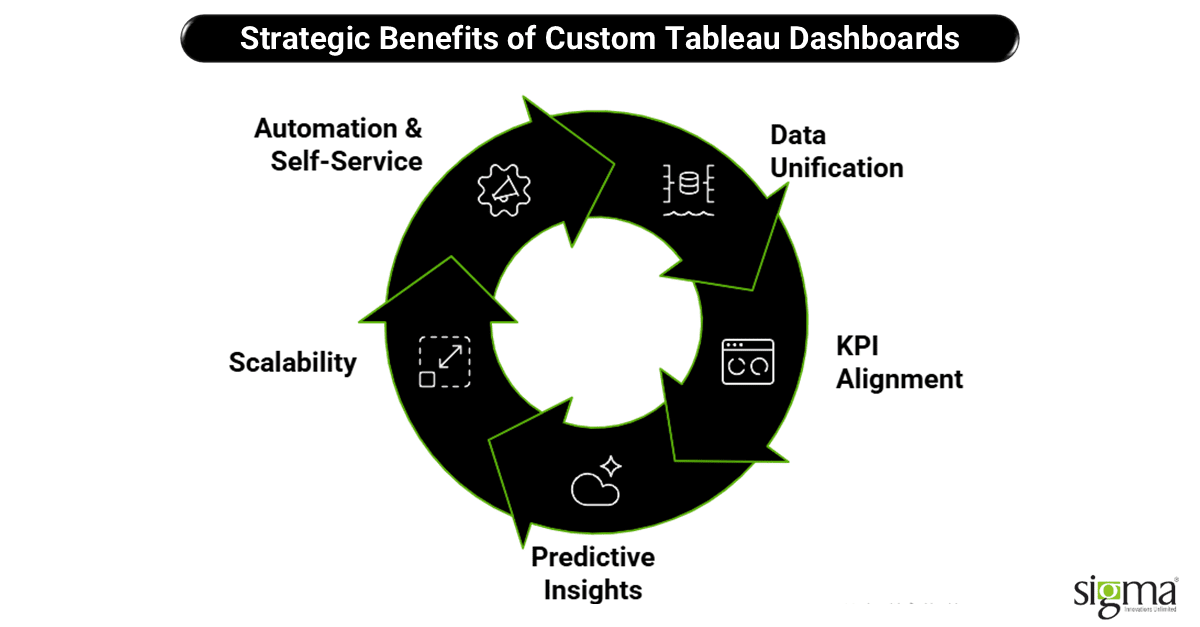
- Data Unification: Custom dashboards break down silos by connecting ERP, CRM, legacy systems, and cloud applications into a single view. This empowers leaders to make decisions from a complete, real-time picture.
- KPI Alignment: Every business has unique measures of success. Tableau dashboard design ensures that the metrics displayed directly reflect strategic objectives—whether it’s customer acquisition costs, fraud detection, or loan performance.
- Predictive Insights: By layering AI and machine learning models into data analytics dashboards, CTOs and CIOs can move beyond descriptive reporting and forecast what’s next.
- Scalability: Custom dashboards grow as your data grows. They’re built to handle high data velocity and complexity without slowing down performance.
- Automation & Self-Service: With automated reporting and intuitive interfaces, teams can pull insights independently without heavy IT intervention—accelerating decision-making across the organization.
In short, creating a Tableau dashboard that is tailored to your enterprise isn’t just about better visuals. It’s about enabling a culture of data-driven decision-making where leaders act faster, reduce operational bottlenecks, and turn data into a true strategic advantage.
For CTOs and CIOs, investing in custom dashboards isn’t optional—it’s mission-critical.
Latest Trends Powering Custom Tableau Dashboards
Custom Tableau dashboards aren’t just about pretty visuals—they’re evolving into powerful decision-making engines that reflect the latest shifts in business intelligence. For CTOs and CIOs, keeping pace with these trends is key to staying competitive in a data-first world.
Here are five trends redefining how custom Tableau dashboards deliver value:
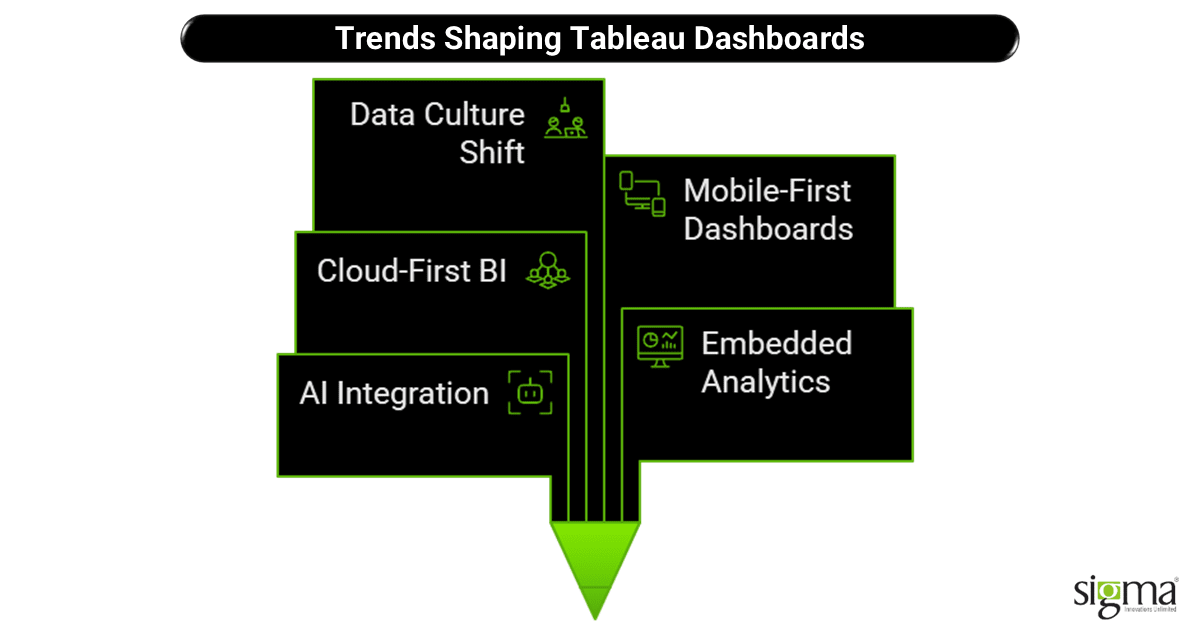
- AI + Tableau: The fusion of Tableau with generative AI and machine learning is unlocking advanced insights. From predictive analytics to automated anomaly detection, AI-driven data analytics dashboards help leaders anticipate market shifts rather than just react to them.
- Embedded Analytics: Dashboards are no longer confined to analysts or BI teams. Through embedded analytics solutions and Tableau API integration, enterprises can bring insights directly into customer portals, partner platforms, or internal workflows—making data accessible to everyone who needs it.
- Cloud-First BI: With enterprises moving rapidly to AWS, Azure, and GCP, Tableau dashboard design now emphasizes seamless cloud integration. Cloud-first BI not only improves scalability but also ensures real-time access across distributed teams.
- Mobile-First Dashboards: Business doesn’t wait for the desktop anymore. Mobile-first custom dashboards empower executives and managers to access KPIs on the go, enabling decisions anytime, anywhere.
- Data Culture Shift: Perhaps the most transformative trend is the cultural one. Companies are moving from data gatekeeping to democratization. By creating a Tableau dashboard that’s intuitive and self-service, employees at every level can contribute to smarter, faster decision-making.
For CTOs and CIOs, these trends underline a simple truth: custom Tableau dashboards aren’t static tools—they’re evolving ecosystems that connect strategy, technology, and people. Leaders who embrace these shifts are better positioned to scale their organizations, empower teams, and stay ahead of disruption.
Also Read: AWS Cloud Solutions for Building Enterprise-Grade Data Lakes
Sigma Infosolutions’ Approach to Custom Tableau Development
At Sigma, we believe custom Tableau dashboards should do more than display data—they should transform the way enterprises make decisions. Our end-to-end Tableau development services are designed to solve the real challenges that CTOs, CIOs, and business leaders face: fragmented systems, data silos, scaling bottlenecks, and time-consuming manual reporting.
Here’s how we approach Tableau development:
- Data Integration: We bring together data from ERPs, CRMs, cloud platforms, APIs, and even legacy systems using advanced ETL pipelines. The result? Unified, real-time insights that leaders can trust.
- Custom Dashboard Design: No two enterprises have the same KPIs. Our Tableau dashboard design process ensures dashboards are aligned with strategic goals, business workflows, and compliance requirements.
- Performance Optimization: Whether you’re analyzing millions of customer transactions or monitoring system uptime, our dashboards are optimized for speed, scalability, and high-volume analytics.
- AI & Predictive Integration: By embedding AI and machine learning models into data analytics dashboards, we help leaders move from reactive to predictive decision-making.
What makes Sigma different is simple: we don’t just build dashboards, we build decision ecosystems. Our goal is to empower enterprises with custom dashboards that adapt as their business grows, enabling smarter strategies and stronger results.
We’ve partnered with organizations across industries to make this vision a reality:
- FinTech – Lending platforms tracking loan performance, risk exposure, and customer acquisition in real-time.
- eCommerce & Retail – Unified dashboards connecting sales, marketing, and supply chain data to optimize customer journeys.
- Healthcare – Patient care dashboards monitoring outcomes, compliance, and operational efficiency.
- Legal & Professional Services – Case management and performance dashboards improving resource allocation.
- Technology ISVs – Embedded analytics solutions with Tableau API integration to enhance product value.
For CTOs and CIOs, our approach means one thing: peace of mind. With Sigma as your BI and analytics partner, you get more than a dashboard—you gain a data-driven foundation to scale your enterprise confidently into the future.
Our case study, “Business Intelligence Reporting Solutions for a US-based Centralized Management Company using Tableau,” highlights how we transformed fragmented reporting into actionable insights, empowering leadership teams to make faster, smarter decisions.
Business Impact: Why CTOs and CIOs Can’t Afford to Wait
In today’s data-first economy, hesitation comes at a cost. For CTOs and CIOs, sticking with generic dashboards or delaying investments in custom Tableau dashboards can create risks that ripple across the business.
The strategic risks are clear:
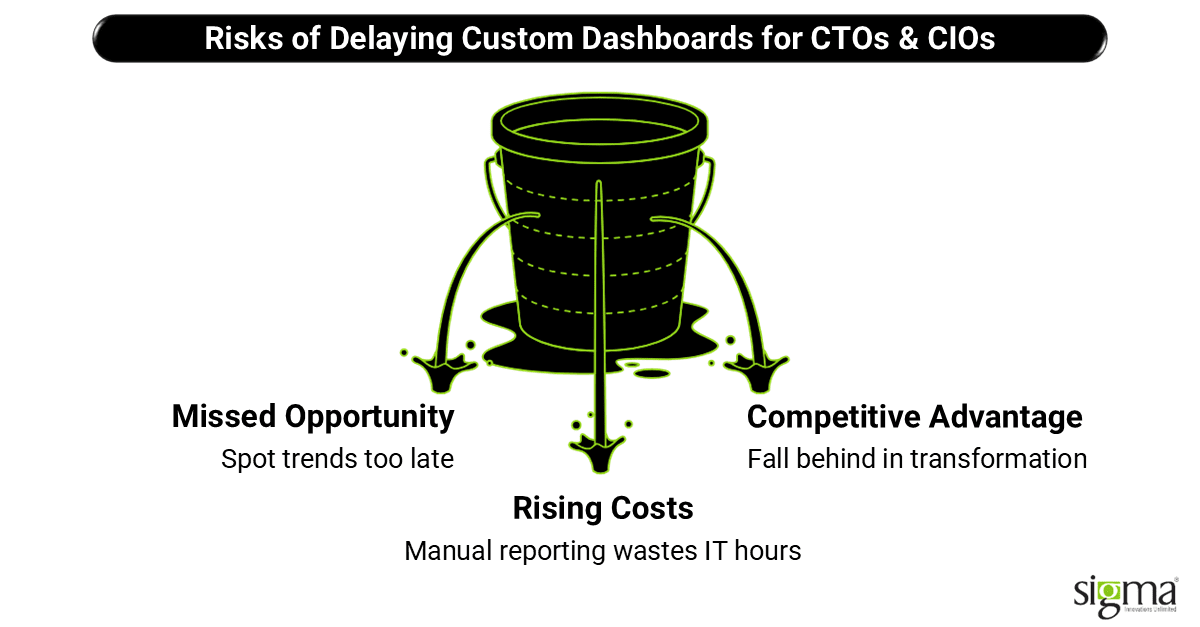
- Missed Opportunities – Without real-time insights, leaders spot trends too late and lose the first-mover advantage.
- Rising Costs – Manual reporting wastes valuable IT hours, increases errors, and slows down critical decision-making.
- Competitive Disadvantage – Enterprises that lack data agility inevitably fall behind in the digital transformation race.
On the flip side, enterprises that embrace custom dashboards see tangible, measurable benefits:
- Faster Time-to-Insight – Tailored Tableau dashboard design reduces complexity, giving leaders the clarity to act immediately.
- Increased Business Agility – With predictive analytics and automation built into data analytics dashboards, companies can pivot strategies quickly when markets shift.
- Stronger Goal Alignment – Dashboards aligned to enterprise KPIs keep the entire organization moving in sync, from the boardroom to operational teams.
For technology leaders, the question isn’t whether to adopt custom dashboards—it’s how soon. In a world where competitors are already investing in advanced BI, waiting means falling behind. The smarter play is clear: leverage custom Tableau dashboards now to gain the clarity, agility, and competitive edge that digital transformation demands.
Future Outlook: The Next 3–5 Years in BI & Analytics
The future of business intelligence is being shaped by three unstoppable forces: AI, cloud, and advanced visualization. Together, they’re redefining what executive dashboards can do. Custom Tableau dashboards won’t just display KPIs—they’ll integrate predictive models, automate insights, and deliver recommendations in real time.
The payoff is huge. According to Snowflake research, 92% of early adopters report seeing ROI from their AI investments. That’s not just a statistic—it’s a competitive reality that CTOs and CIOs can’t afford to ignore.
In this new landscape, technology leaders won’t be satisfied with consuming data; they’ll become data strategists and culture builders. CIOs will lead governance and ethical AI adoption, while CTOs push the boundaries of innovation with Tableau API integration, embedded analytics, and mobile-first BI experiences. The role of the C-suite is shifting from asking, “What happened?” to confidently answering, “What should we do next?”
At Sigma, our mission is to help enterprises stay ahead of this curve. By combining Tableau development services with AI integration, cloud scalability, and domain-specific expertise, we future-proof decision-making ecosystems. For fintechs, eCommerce companies, and ISVs, that means turning dashboards into engines of growth, agility, and resilience.
The next 3–5 years will separate companies that adapt from those that fall behind. With custom Tableau dashboards as the foundation, Sigma empowers CTOs and CIOs to lead—not just manage—the future of data-driven enterprise.
Final Thoughts
In a world where data is everywhere but clarity is rare, custom Tableau dashboards have become the difference between simply tracking numbers and truly transforming strategy. For CTOs and CIOs, they are no longer optional—they’re the lens that brings business priorities, KPIs, and future goals into sharp focus.
The reality is simple: your dashboards should reflect your enterprise, not just your data. Off-the-shelf solutions might give you snapshots, but they won’t provide the tailored insights needed to fuel innovation, ensure compliance, and accelerate digital transformation.
At Sigma Infosolutions, we partner with technology leaders to go beyond dashboard design. Our Tableau development services help unify data sources, automate reporting, embed AI-driven insights, and create scalable ecosystems that grow with your business. Whether you’re in FinTech, eCommerce, healthcare, or building the next-gen ISV product, we deliver dashboards that don’t just inform—they drive measurable impact.
If you’re ready to transform how your enterprise makes decisions, it’s time to move beyond templates. Discover how Sigma can help you build custom Tableau dashboards that empower faster, smarter, and more confident decisions!

